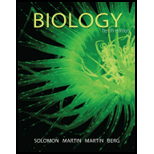
Concept explainers
Introduction: The most advanced placental mammals are the primates. Primates are mammals that lead an arboreal mode of life, except humans who lead terrestrial mode of life. They evolved during the Cenozoic era. The primate evolution began from Africa and there are several excavated evidences to support this theory.
Answer to Problem 1TYU
Correct answer: The first primates evolved from shrew-like placental mammals. Hence, the correct answer is option (c).
Explanation of Solution
Reasons for the correct answer:
Evolution of animals is often explained with the help of fossil evidences, body structure, and DNA analysis of fossils. Based on the available evidences, paleontologists hypothesize that shrew-like placental mammals are the immediate ancestors of the first primates that evolved. The earliest known primate is Plesiadapis, which shares several features with shrews.
Option (c) is given as “shrewlike placental mammals”.
The first primates shared several features with the shrews; hence, they are said to have evolved from shrew-like placental mammals. Thus, the correct answer is option (c).
Reasons for incorrect answers:
Option (a) is given as “shrewlike monotremes”.
Shrewlike monotremes are not the ancestors of the first primates. Montremes are not placental mammals. Primates are placental mammals. Hence, option (a) is incorrect.
Option (b) is given as “therapsids”.
Therapsids gave rise to the first mammals. They are not the direct ancestors of primates. Shrew-like placental mammals are the direct ancestors of the primates. Hence, option (b) is incorrect.
Option (d) is given as “tarsiers”.
Tarsiers are not the first primates. They are the second level of primates to have evolved. Tarsiers evolved from Simians. Hence, option (d) is incorrect.
Option (e) is given as “shrewlike marsupials”.
Shrewlike marsupials are not the ancestors of the first primates. Marsupials are not placental mammals. Primates are placental mammals. Hence, option (e) is incorrect.
Hence, options (a), (b), (d), and (e) are incorrect.
The first primates shared several features with the shrews; hence, they are said to have evolved from shrew-like placental mammals.
Want to see more full solutions like this?
Chapter 22 Solutions
Biology (MindTap Course List)
- Why do you think baleen whales are generally larger than toothed whales? Why are they capable of growing larger than even the largest dinosaurs?arrow_forwardFossils suggest that the first major trait distinguishing human primates from other primates was __________.arrow_forwardwhat do fossils tell us about the evolutionary history of the animal kingdom?arrow_forward
- The evolution of which of the following features of mammals is hardest to trace through the fossil record? a. Jaw structure b. Mammary glands c. Middle ear structure d. Development of hairarrow_forwardIf you discovered a fossil bird with scales on the body & teeth in the beak. What would youconclude about its position in the animal kingdom?arrow_forwardReptiles faced a number of challenges as they moved farther away from sources of water. (Similarly, to amphibians).A.) what were some of the challenges reptiles faced?B.) and how did they overcome those challenges? (Evolutionary, adaptation...)arrow_forward
- The fossil record shows that the first mammals evolved 220 million years ago. The supercontinent Pangaea began to break apart 200 million years ago. On which continents would you predict that fossils of the first mammals will be found?arrow_forwardWhat is present on the feet of birds which provides more evidence for their evolution from reptiles and dinosaurs?arrow_forwardIn 1928 Walter Garstang hypothesized that tunicates resemble the ancestral stock of the vertebrates. Explain this hypothesis and evaluate its validity with recent phylogenetic, fossil, and developmental data.arrow_forward
 Human Anatomy & Physiology (11th Edition)BiologyISBN:9780134580999Author:Elaine N. Marieb, Katja N. HoehnPublisher:PEARSON
Human Anatomy & Physiology (11th Edition)BiologyISBN:9780134580999Author:Elaine N. Marieb, Katja N. HoehnPublisher:PEARSON Biology 2eBiologyISBN:9781947172517Author:Matthew Douglas, Jung Choi, Mary Ann ClarkPublisher:OpenStax
Biology 2eBiologyISBN:9781947172517Author:Matthew Douglas, Jung Choi, Mary Ann ClarkPublisher:OpenStax Anatomy & PhysiologyBiologyISBN:9781259398629Author:McKinley, Michael P., O'loughlin, Valerie Dean, Bidle, Theresa StouterPublisher:Mcgraw Hill Education,
Anatomy & PhysiologyBiologyISBN:9781259398629Author:McKinley, Michael P., O'loughlin, Valerie Dean, Bidle, Theresa StouterPublisher:Mcgraw Hill Education, Molecular Biology of the Cell (Sixth Edition)BiologyISBN:9780815344322Author:Bruce Alberts, Alexander D. Johnson, Julian Lewis, David Morgan, Martin Raff, Keith Roberts, Peter WalterPublisher:W. W. Norton & Company
Molecular Biology of the Cell (Sixth Edition)BiologyISBN:9780815344322Author:Bruce Alberts, Alexander D. Johnson, Julian Lewis, David Morgan, Martin Raff, Keith Roberts, Peter WalterPublisher:W. W. Norton & Company Laboratory Manual For Human Anatomy & PhysiologyBiologyISBN:9781260159363Author:Martin, Terry R., Prentice-craver, CynthiaPublisher:McGraw-Hill Publishing Co.
Laboratory Manual For Human Anatomy & PhysiologyBiologyISBN:9781260159363Author:Martin, Terry R., Prentice-craver, CynthiaPublisher:McGraw-Hill Publishing Co. Inquiry Into Life (16th Edition)BiologyISBN:9781260231700Author:Sylvia S. Mader, Michael WindelspechtPublisher:McGraw Hill Education
Inquiry Into Life (16th Edition)BiologyISBN:9781260231700Author:Sylvia S. Mader, Michael WindelspechtPublisher:McGraw Hill Education





